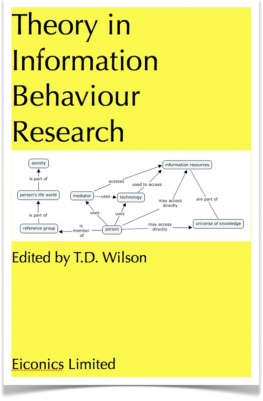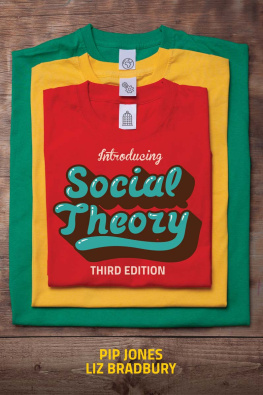ISBN 978-3-11-051565-7
e-ISBN (PDF) 978-3-11-051566-4
e-ISBN (EPUB) 978-3-11-051580-0
Library of Congress Cataloging-in-Publication Data
Names: Redmond, Mark V., 1949- author.
Title: Social decentering : a theory of other-orientation encompassing empathy and perspective-taking / Mark Redmond.
Description: Berlin ; Boston : Walter de Gruyter, [2018] | Includes bibliographical references and index.
Identifiers: LCCN 2018008279 | ISBN 9783110515657 (softcover)
Subjects: LCSH: Social perception. | Empathy. | Social interaction.
Classification: LCC HM1041 .R43 2018 | DDC 302--dc23 LC record available at https://lccn.loc.gov/2018008279
Bibliographic Information Published by the Deutsche Nationalbibliothek
The Deutsche Nationalbibliothek lists this publication in the Deutsche Nationalbibliografie; detailed bibliographic data are available on the Internet at http://dnb.dnb.de.
2018 Walter de Gruyter GmbH, Berlin/Boston
Cover illustration: Mark V. Redmond
www.degruyter.com
Dedicated to Dr. Frank Dance, Dr. Carl Larson, and the late Dr. Alton Barbour and Dr. Al Goldberg. Its been a long journey since each of them guided my dissertation on empathy and communication competence, but the influence of their wisdom never wanes. Also, in remembrance of fellow students who began that journey with me but who are no longer here to see the finale: Dr. Norm Watson, Dr. Jim Toulhuizen, and Dr. Marc Routhier.
This book is also dedicated to all those who seek to make this a better world with their willingness to consider the perspectives, values, beliefs, thoughts, feelings, and experiences of those who provide them love and support, and those who challenge and confront them.
Acknowledgments
I owe a very large debt of gratitude to Lori Peterson, who edited several of my chapters. Her attention to detail and wordsmithing often turned my gibberish into meaningful prose. Thank you Lori. My thanks also to Dr. Phil Backlund and Dr. Katherine Rafferty for reading some of the chapters and providing constructive feedback. I am indebted to my colleague, Dr. Denise Vrchota, for providing her moral support and a kind ear throughout the development and writing of this book. Thanks to my wife, Peggy, for her understanding and patience while I whiled away the hours writing. A special thanks to Anja Cheong, acquisitions editor of De Gruyter for her enthusiastic support, encouragement, and guidance. I particularly appreciated her openness to even my most trivial questions and her helpful responses. And finally, my gratitude to Frauke Schafft and Janine Conrad at De Gruyter for helping me through the production process.
Preface/Introduction
The following comments are intended to align your expectations as a reader with those of mine as the writer by primarily explaining what is not included in this book. If you have elected to read this book of your own accord (versus an assigned reading for a class), you might be expecting a thorough, detailed discussion of empathy and perspective-taking, but you will not find that. Many years ago, after considerable time reviewing the literature on empathy, perspective-taking, and role-taking, I wrote a convention paper where I detailed the confusion surrounding the meaning and measurement of those concepts. As a solution, I decided to erase the board and start with a blank slate and a new term. Since that time, others have also languished over the confusion of the meaning of the terms empathy and perspective-taking, often merging them together in attempts to more clearly identify boundaries and meaning resulting in such terms as empathic perspective- taking, affective perspective-taking, and cognitive empathy. Other scholars have also discussed these issues of conceptual confusion, so there is no need to rehash those issues here.
Instead, the focus of this book is to explain and expand on the theory of social decentering, though I will review research and theory on empathy and perspective-taking, insofar as they provide support and clarity to social decentering. I originally published an abbreviated description of social decentering and a measure of social decentering in the Journal of Research in Personality (Redmond, 1995). This book includes a comprehensive discussion of social decentering theory which I argue is a multidimensional theory that encompasses empathy and perspective-taking. Among the goals of the theory is to provide a framework that solves many of the issues that have confronted research and theory in empathy and perspective-taking. But the social decentering theory goes beyond simply combining knowledge about empathy and perspective-taking, to provide an innovative model that explains the process people use when analyzing another persons thoughts, feelings, and dispositions.
Initially, I drew from the work of Jean Piaget (1950, 1974) in using the term decentering, but I came to realize the use of that term would prove too limiting, since for Piaget, decentering focused on childrens recognition of physical perspectives. My interest was in how people apply the same general process, not just to their physical world, but to their entire social world more specifically, to seeing the world from another persons perspective. Thus, I added the term social to decentering to more accurately reflect the phenomenon I wished to study social decentering.
I believe that social decentering theory is the theory that would emerge after you shake together all of the main conceptual components associated with empathy, perspective-taking, and role-taking and then pour them out into a single mold. The theory of social decentering reflects a way of organizing the most significant elements of other-oriented concepts to create a unified theory. But more importantly, my goal was to create a theory that is a true reflection of the social cognitive process that takes place when a person considers another persons dispositions within a given situation. I use the term disposition as a catchall term because I got tired of listing the multitude of elements a person might review when considering another persons world their perspectives, thoughts, feelings, attitudes, needs, world view, beliefs, values, biases, education, experiences, race, sex, age, and so on. Nonetheless, when explaining social decentering, I refer to efforts to consider another persons thoughts, feelings, and other dispositions. I explicitly identify thoughts and feelings in addition to disposition to emphasize two of the major elements that constitute other-orientation the cognitive and the affective.
In choosing to focus on social decentering as a form of social cognition, other areas of theory and research related to empathy and perspective-taking are excluded. For example, I do not review or include theory and research related to empathy from a neurological perspective. The reason for excluding this material is again to differentiate a conscientious process from a neurological reaction such as motor mimicry. A significant amount of research that involves mapping neurological responses to perceptions of others has resulted in identifying mirror neurons. On the most basic level, mirror neurons occur when the same neuron that is triggered in one animal is triggered in another animal who observes the first. I use this to explain to my wife why I grunt when Im watching football on TV and grunt when a player is tackled my physiological reaction or motor mimicry is mildly similar to what the player experienced my neurons are mirroring his. One can argue that my neurological response then provides me with information about what the player must have experienced which provides a basis for empathizing with him. Bayne and Hays (2017) point out that knowing what neural pathways are illuminated in response to anothers emotions does not provide a full realization of empathy in an interpersonal context (p. 33). In addition, discovering shared neuropathways fails to reflect the other thoughts that occur as observers experience emotions. The social cognitive aspects of social decentering go beyond neuro-emotional responses as individuals think about the person, the situation, and themselves as they make sense of the emotional response. Thus, to maintain the focus on the deliberative process that surrounds being other oriented, the research and theory related to the neurological perspective is not included.









